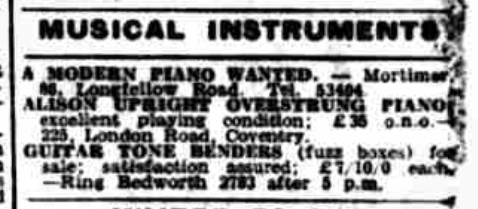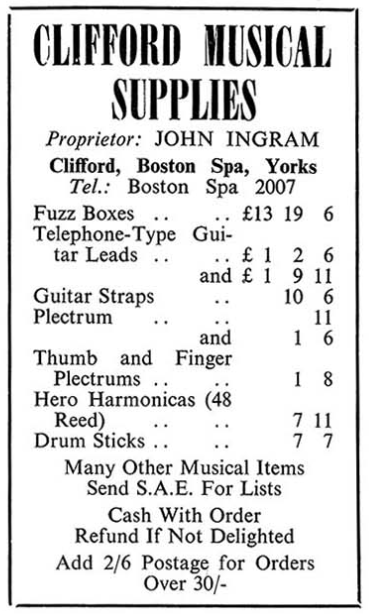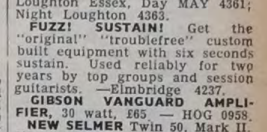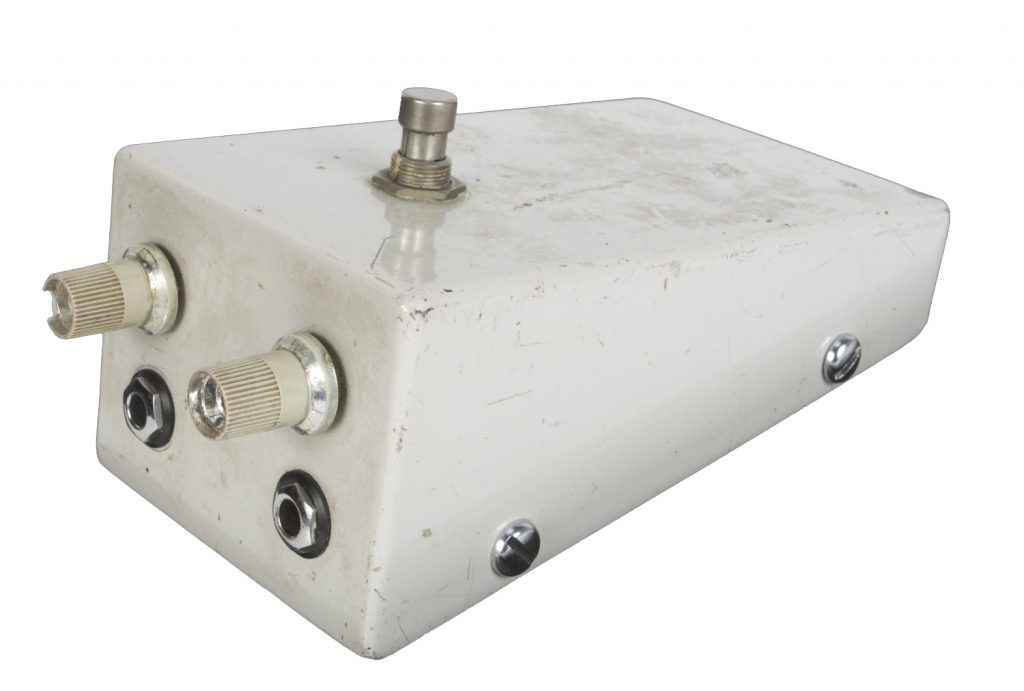The majority of the fuzz boxes featured on Fuzzboxes.org were manufactured (or at least marketed) by major brands in the British guitar industry. Pedals branded for the likes of Marshall, Dallas, Carlsbro, WEM, and so on, were sold at retail outlets during the 1960s. In some cases, fuzz boxes were also reported to have been demonstrated at trade fairs, and consequently, many distinctly ‘British’ fuzz boxes were actually sold abroad too.
This page focuses on some of the much smaller-scale activity going on in different parts of the UK. Similar to the present-day online ‘boutique’ pedal scene, early fuzz boxes were already being cobbled together in the 1960s. This would have been done by both hobbyists and small-time entrepreneurs alike, and these small-time guitar effects businesses weren’t confined to Denmark Street either.
Naturally, there is some crossover between mass-produced effects units, and custom, bespoke fuzz boxes. People like Gary Hurst and Pepe Rush initially supplied their early creations directly to musicians, in a manner that nowadays might be described as being ’boutique’, until they were supported (and eventually taken over) by Macari’s Musical Exchange & WEM (respectively).

Tone Benders were listed for sale in the Coventry Evening Telegraph, on the 7th of March, 1966. It’s possible that the person in Bedworth was retailing the Sola Sound Tone Bender ‘MK1.5’, based on the date of the advert.
The stipulation in the text, however, about only accepting enquiries after 5PM suggests that the seller may have been operating privately, as opposed to through a formal storefront. It is therefore possible that the seller was manufacturing these fuzz boxes themselves, and simply described them as ‘Tone Benders’ in the generic sense of the phrase.
An assurance of “satisfaction” may also be a clue that the seller was trying to capitalise on the surge of interest in the fuzz guitar sound, following the Rolling Stones 1965 single of that name.

Fuzz Boxes sold in Essex, advertised in Melody Maker on the 9th of April, 1966, were described only by their pair of jack sockets and a footswitch. It’s possible that these units didn’t have control knobs (not unlike the Vox Distortion Booster), but the manufacturer may also have simply kept their advertisement basic, and purposefully omitted any further details about the units.

Clifford Musical Supplies, in Yorkshire, sold fuzz boxes of some sort in 1966. The shop ran advertisements in Banjo Mandolin Guitar (BMG) magazine, in the August & September 1966 issues.
These fuzz boxes might have been supplied to the shop by a small-time builder, or Clifford Musical Supplies could have simply also have been stocking pedals from one of the ‘major’ brands at the time (such as the Zonk Machine, for example, also from Yorkshire).

“New” Fuzz units from West Sussex were advertised in Melody Maker, on the 11th of November, 1968. Curiously, the model was priced the same as the “Tone Bender” in Coventry, over two years earlier, but this is likely to just be a coincidence, given the time between the two.
It appears as though the ‘boutique pedals’ activity petered out somewhat after 1966. This could, in part, be attributed to the fact that manufacturers like Arbiter and Sola Sound had begun to properly mass-produce their pedals by 1967, and that commercial fuzz boxes had generally become more affordable and widely available, compared to when the post-’Satisfaction’ craze of 1965 first began.

According to testimony from the original owner, this ‘Anglo’ fuzz box was purchased from a small advertisement in the back of a music magazine in the mid-1960s.1
An exact date of production is impossible to ascertain, and without knowing exact which publication it might have been advertised in, it’s very difficult to match the ‘Anglo’ pedal to any of the known advertisements. (Thanks to S. Murphy.)
Well known guitarists who are reported at one point to have owned custom-made fuzz boxes include Syd Barrett, who at one point owned a pedal that was made for him out of “bits of other fuzz boxes”.2
Jeff Beck was apparently already using a fuzz box before his time with the Yardbirds. One of Beck’s earliest forays into the fuzz guitar sound came in the form of a unit built for him by Tridents bandmate, Paul Lucas.3
The Magic Lanterns reportedly had a fuzz box specially built for the 1966 ‘Rumpelstiltskin‘ session. The unit was described as having two fuzz circuits connected together.4
By far the most widely documented ‘small-time’ British fuzz box builder, active in the 1960s, is Roger Mayer. Well known for supplying Jimi Hendrix with the Octavia in 1967, Mayer was also responsible for putting early fuzz boxes into the hands of session guitarists, as early as in 1964.5
Jimmy Page credits Roger Mayer for having supplied him with a fuzz box in 1964, during the early part of Page’s career, and corroborates Mayer’s claim that Jeff Beck received one as well.6
Photographic evidence suggests that Jimmy Page had replaced his Roger Mayer unit with various versions of the Sola Sound Tone Bender by the time that he had joined the Yardbirds.

Roger Mayer advertised his “troublefree” fuzz boxes to the general public as well. Published in the February 5th 1966 issue of Melody Maker, the text corroborates his units having been available since 1964. (Thanks to Roger Mayer, for confirming the advert as being his.)
The Nashville Teens were credited as being early adopters of the fuzz-guitar sound,7 and they, too, acquired a very early fuzz box from Roger Mayer, who was a friend of the band. Their fuzz box was used on the recording of the 1966 single, ‘That’s my woman’.8

No surviving examples of Mayer’s fuzz boxes, built ‘pre-Hendrix’, are known to have survived. Mayer apparently continued supplying pedals to professional musicians after starting his work with Hendrix, and a very small handful of late-1960s, white, wedge-shaped Roger Mayer fuzz boxes have survived.
The white Octavia, pictured here, belonged to Jerry Guida, who was allegedly given it by Jimi Hendrix. The unit was sold at auction in 2020. (Photo credit: Julien’s Auctions)
Given that all of the fuzz boxes listed on this page would have only been made in relatively small numbers, it’s not surprising that the majority haven’t survived to emerge on the Internet. But while the identities & stories behind the various individual models are likely to be forever lost in time, clues in the press & anecdotes from guitar players of the time still paint a slightly less London-centric picture of the growing interest and demand for the fuzz sound.
- https://stompboxes.co.uk/forum/viewtopic.php?f=6&t=10009
- Melody Maker, 26th August 1967, p. 10
- Warburton, Nick, The Tridents, 2015 [https://thestrangebrew.co.uk/interviews/the-tridents/]
- Beat Instrumental, October 1966, p. 8
- Mayer, Roger, Roger Mayer – History, 1st October 1999 [https://web.archive.org/web/19991001064756/http://www.roger-mayer.co.uk:80/history.htm]
- Absolute Radio, Jimmy Page talks about the invention of the distortion pedal, 17th October 2014 [https://www.youtube.com/watch?v=8HHVHceTh8c]
- Melody Maker, February 5th 1966, p. 16
- J. Allen, via R. Allen (personal communication, 7th April 2020)
